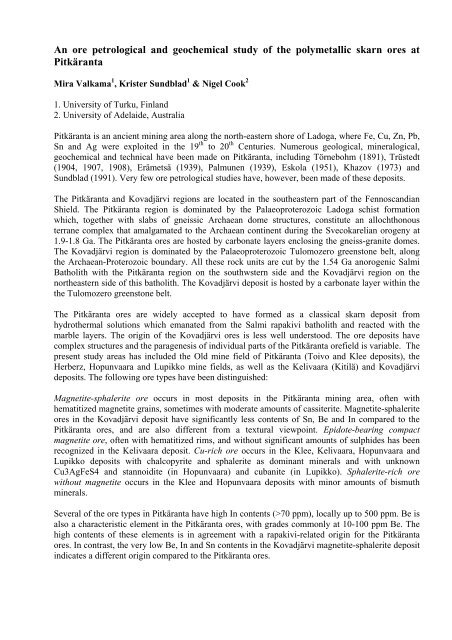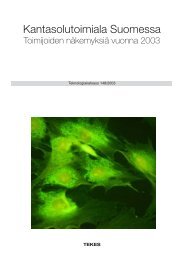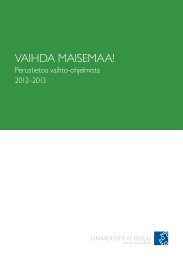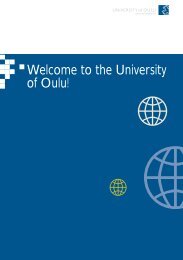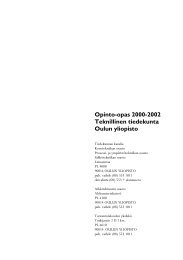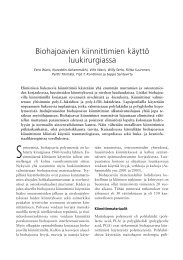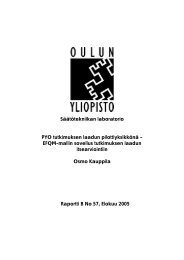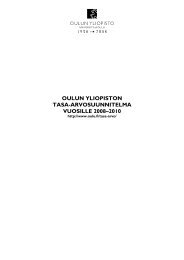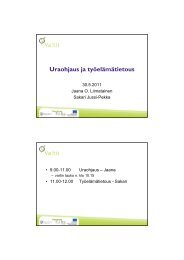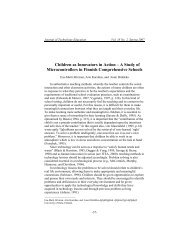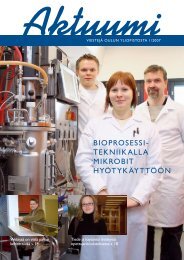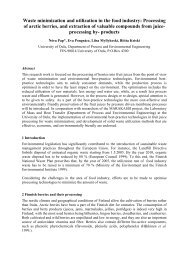Meeting programme - Oulu
Meeting programme - Oulu
Meeting programme - Oulu
You also want an ePaper? Increase the reach of your titles
YUMPU automatically turns print PDFs into web optimized ePapers that Google loves.
An ore petrological and geochemical study of the polymetallic skarn ores at<br />
Pitkäranta<br />
Mira Valkama 1 , Krister Sundblad 1 & Nigel Cook 2<br />
1. University of Turku, Finland<br />
2. University of Adelaide, Australia<br />
Pitkäranta is an ancient mining area along the north-eastern shore of Ladoga, where Fe, Cu, Zn, Pb,<br />
Sn and Ag were exploited in the 19 th to 20 th Centuries. Numerous geological, mineralogical,<br />
geochemical and technical have been made on Pitkäranta, including Törnebohm (1891), Trüstedt<br />
(1904, 1907, 1908), Erämetsä (1939), Palmunen (1939), Eskola (1951), Khazov (1973) and<br />
Sundblad (1991). Very few ore petrological studies have, however, been made of these deposits.<br />
The Pitkäranta and Kovadjärvi regions are located in the southeastern part of the Fennoscandian<br />
Shield. The Pitkäranta region is dominated by the Palaeoproterozoic Ladoga schist formation<br />
which, together with slabs of gneissic Archaean dome structures, constitute an allochthonous<br />
terrane complex that amalgamated to the Archaean continent during the Svecokarelian orogeny at<br />
1.9-1.8 Ga. The Pitkäranta ores are hosted by carbonate layers enclosing the gneiss-granite domes.<br />
The Kovadjärvi region is dominated by the Palaeoproterozoic Tulomozero greenstone belt, along<br />
the Archaean-Proterozoic boundary. All these rock units are cut by the 1.54 Ga anorogenic Salmi<br />
Batholith with the Pitkäranta region on the southwstern side and the Kovadjärvi region on the<br />
northeastern side of this batholith. The Kovadjärvi deposit is hosted by a carbonate layer within the<br />
the Tulomozero greenstone belt.<br />
The Pitkäranta ores are widely accepted to have formed as a classical skarn deposit from<br />
hydrothermal solutions which emanated from the Salmi rapakivi batholith and reacted with the<br />
marble layers. The origin of the Kovadjärvi ores is less well understood. The ore deposits have<br />
complex structures and the paragenesis of individual parts of the Pitkäranta orefield is variable. The<br />
present study areas has included the Old mine field of Pitkäranta (Toivo and Klee deposits), the<br />
Herberz, Hopunvaara and Lupikko mine fields, as well as the Kelivaara (Kitilä) and Kovadjärvi<br />
deposits. The following ore types have been distinguished:<br />
Magnetite-sphalerite ore occurs in most deposits in the Pitkäranta mining area, often with<br />
hematitized magnetite grains, sometimes with moderate amounts of cassiterite. Magnetite-sphalerite<br />
ores in the Kovadjärvi deposit have significantly less contents of Sn, Be and In compared to the<br />
Pitkäranta ores, and are also different from a textural viewpoint. Epidote-bearing compact<br />
magnetite ore, often with hematitized rims, and without significant amounts of sulphides has been<br />
recognized in the Kelivaara deposit. Cu-rich ore occurs in the Klee, Kelivaara, Hopunvaara and<br />
Lupikko deposits with chalcopyrite and sphalerite as dominant minerals and with unknown<br />
Cu3AgFeS4 and stannoidite (in Hopunvaara) and cubanite (in Lupikko). Sphalerite-rich ore<br />
without magnetite occurs in the Klee and Hopunvaara deposits with minor amounts of bismuth<br />
minerals.<br />
Several of the ore types in Pitkäranta have high In contents (>70 ppm), locally up to 500 ppm. Be is<br />
also a characteristic element in the Pitkäranta ores, with grades commonly at 10-100 ppm Be. The<br />
high contents of these elements is in agreement with a rapakivi-related origin for the Pitkäranta<br />
ores. In contrast, the very low Be, In and Sn contents in the Kovadjärvi magnetite-sphalerite deposit<br />
indicates a different origin compared to the Pitkäranta ores.


